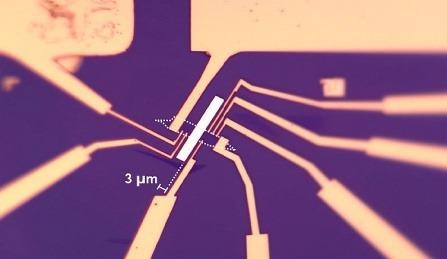Feb 26 2021
Graphene is unbelievably strong, conductive, lightweight and the list of its superior properties continues.
 The image shows eight electrodes around a 20 nm-thick magnet (white rectangle) and graphene (white dotted line). Image Credit: University at Buffalo.
The image shows eight electrodes around a 20 nm-thick magnet (white rectangle) and graphene (white dotted line). Image Credit: University at Buffalo.
However, graphene lacks one main property—it is not magnetic, and this drawback has dwarfed its applications in spintronics, a rising field which, according to researchers, could ultimately rewrite the rules of electronics, resulting in more robust computers, semiconductors and other devices.
Led by the University at Buffalo (UB), an international group of researchers has now reported progress that could help surpass this barrier.
A study published recently in the Physical Review Letters journal explains how a magnet was paired with graphene to induce a so-called 'artificial magnetic texture' in the nonmagnetic wonder material.
Independent of each other, graphene and spintronics each possess incredible potential to fundamentally change many aspects of business and society. But if you can blend the two together, the synergistic effects are likely to be something this world hasn’t yet seen.
Nargess Arabchigavkani, Study Lead Author and Postdoctoral Research Associate, SUNY Polytechnic Institute
Arabchigavkani carried out the study while she was a PhD candidate at UB.
The other authors of the study are from UB, King Mongkut’s Institute of Technology Ladkrabang in Thailand, Chiba University in Japan, University of Science and Technology of China, University of Nebraska Omaha, University of Nebraska Lincoln, and Uppsala University in Sweden.
The researchers performed their experiments by placing a magnet with a thickness of 20 nm in direct contact with a graphene sheet—a single layer of carbon atoms aligned in a two-dimensional honeycomb lattice with a thickness below 1 nm.
To give you a sense of the size difference, it’s a bit like putting a brick on a sheet of paper.
Jonathan Bird, PhD, Study Senior Author, Professor and Chair of Electrical Engineering, School of Engineering and Applied Sciences, University at Buffalo
Then, the researchers placed eight electrodes in various spots near the graphene and magnet to quantify their conductivity.
A surprising attribute was disclosed by the electrodes—the magnet activated an artificial magnetic texture in the graphene that remained even in regions of the graphene distant from the magnet. In simple terms, the intimate contact present between the two objects made the usually nonmagnetic carbon behave unusually, displaying magnetic properties quite similar to common magnetic materials such as cobalt or iron.
It was discovered that these properties could surpass the natural properties of the graphene entirely, even when observed at several microns away from the contact point of the magnet and the graphene. Although this distance (a micron is a millionth of a meter) is unbelievably small, it is comparatively huge in microscopic terms.
The study results lead to essential questions concerning the microscopic origins of graphene’s magnetic texture.
Most significantly, Bird stated that it is the degree to which the induced magnetic behavior emerges from the impact of spin polarization and/or spin-orbit coupling—phenomena that are known to be closely related to the magnetic properties of materials and also to the rising technology of spintronics.
Instead of using the electrical charge carried by electrons (similar to conventional electronics), spintronic devices resort to leveraging the special quantum property of electrons called spin (which is similar to the earth spinning on its own axis).
Spin provides the ability to pack more information into smaller devices, thus raising the power of quantum computers, mass storage devices, semiconductors and other digital electronics.
The study was financially supported by the U.S. Department of Energy. More support was offered by the U.S. National Science Foundation; nCORE, a 100% owned subsidiary of the Semiconductor Research Corporation; the Swedish Research Council; and the Japan Society for the Promotion of Science.
Journal Reference:
Arabchigavkani, N., et al. (2021) Remote Mesoscopic Signatures of Induced Magnetic Texture in Graphene. Physical Review Letters. doi.org/10.1103/PhysRevLett.126.086802.